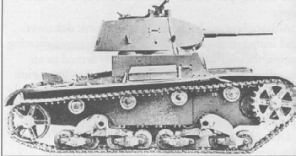
|
| Victory Points |
Armour | Start | Start | End | End | ||
| Front | Side | Rear | Month | Year | Month | Year | |
| 3 | 3 | 1 | 1 | 11 | 39 | 12 | 42 |
| T-26 Light Infantry Tank | ||||||||||||||||||||
| RANGE | 1 | 2 | 3 | 4 | 5 | 6 | 7 | 8 | 9 | 10 | 11 | 12 | 13 | 14 | 15 | 16 | 17 | 18 | 19 | 20 |
| HARD | 8 | 5 | 3 | . | . | . | . | . | . | . | . | . | . | . | . | . | . | . | . | . |
| SOFT | 6 | 5 | 4 | 3 | 2 | . | . | . | . | . | . | . | . | . | . | . | . | . | . | . |

|
T-26 Light Infantry Tank
|
Specification |
|
The T-26 light tank was an unashamed copy of the Vickers 6-ton tank , a commercial model produced during the late 1920s and sent to the Soviet Union in 1930.The T-26A had twin 7.62 mm (0.30 in) machine gun turrets (late variants featured heavy machine guns) while the later T-26B had a single turret mounted 37 mm (1.46 in) high-velocity gun.The final model the T-26S Model 1937 or T-26C had a 45 mm (1.78 in) gun , heavier armour , a rounded-off welded hull and a revised turret. Not all T-26s were gun tanks.The OT-26 was a flame-thrower variant of the T-26A while the OT-130 was based on the T-26B : the OT-133 was the T-26S equivalent.The most extreme T-26 variant was a glider produced by strapping wings and a tail unit directly onto a T-26! Its service career if any is uncertain.Bulky pontoons were designed to provide limited amphibious capability. The T-26 series provided a high proportion of Soviet tank strength in 1941 when they took part in the Soviet invasion of Iran (in co-operation with British troops).They had seen action already in the Spanish Civil War and during the Russian attack on Finland in 1940.Most were lost in battle against the Germans in 1941-42.The T-26s captured by the Germans were usually impressed as infantry support tanks while an undefined number were converted as Panzerjager carrying French 75 mm (2.96 in) anti-tank guns. |